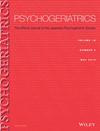Education correction for neurocognitive testing
IF 1.7
4区 医学
Q3 GERIATRICS & GERONTOLOGY
引用次数: 0
Abstract
Comprehensive neuropsychological assessments, composed of specific tests targeting different aspects of cognition, are standard diagnostic tools to characterise the singleor multidomain impairments due to neurodegeneration, depression, or other brain disorders. Individual test results are frequently corrected for age-related changes in performance, and for the years of formal education, a proxy measure for cognitive reserve, that also comprises occupational attainment and intelligence. Education correction for neurocognitive tests could influence a physician’s decision how to diagnose and treat an individual, and has been used to reclassify demented and nondemented individuals in diagnostic assessments. Others point to education differences in European and American populations to explain heterogeneous performances in a common screening test for cognitive impairment. Both scenarios imply that we expect a well-educated person to perform better, reflected by a correlation between the years of formal education and cognitive abilities. We hypothesised that generational differences in education opportunities would challenge this assumption. In the 20th century, many societies experienced substantial changes in education opportunities, specifically regarding access to university education. This is reflected by an increasing percentage of university students in these populations and a strong shift in the ratio of men and women attending the institutions. In Germany for example, ‘universities of applied sciences’ have complemented the higher education sector since the 1970s, increasing tertiary education possibilities in addition to other quantitative changes in the education system. Furthermore, over the course of the last century, high tertiary education inequality due to social class effects has been substantially declining, specifically for women. We investigated 276 people (age range 44–94 years, median: 73 years, 124 male, 152 female), presenting for the first time to a German university memory clinic with cognitive impairment in the spectrum from subjective complaints to dementia. Written informed consent was obtained in accordance with the university’s ethics committee requirements. In addition to an interview (with caregiver, if available) and examination by an experienced physician, all patients underwent routine laboratory testing, magnetic resonance brain imaging and detailed neuropsychological assessments, in line with standard guidelines for how to evaluate cognitive impairment. We performed the statistical analyses using SPSS 24.0 (IBM, Armonk, NY, USA), with a significance level of P < 0.05, two-sided, for all analyses. Participants reporting university education (n = 101) compared with all other individuals (n = 175) were more likely to be older, male, and intrinsically motivated for diagnostic assessments, possibly reflecting the protective effect of cognitive reserve, gender differences in education opportunities, and greater dementia worries. We also found weak to moderate correlations between the years of formal education and a multiple choice vocabulary test, a common measure of premorbid intelligence. The correlation strength shows a notable trend for linear decline with increasing age (from Pearson’s r = 0.60, P = 0.01 among our youngest subjects to Pearson’s r = 0.30, P = 0.02 in our oldest participants, Fisher’s z-transformation: z = 1.38, P = 0.08). However, this can only be detected among subjects without university education (patients younger than 65 years: Pearson’s r = 0.39, P < 0.01; patients older than 65 years: Pearson’s r = 0.12, P = 0.28, z = 1.50, P = 0.07), but not among those individuals with university education (patients younger than 65 years Pearson’s r = 0.20, P = 0.46; patients older than 65 years: Pearson’s r = 0.30, P = 0.02, z = 0.35, P = 0.37). When investigating patients with dementia only, we did not observe the effect. The multiple choice vocabulary test is a valid measure of global premorbid intelligence, appropriately insensitive for the influence of neuropsychiatric disease. Considering the test’s limitations, our data would be in line with reduced validity in the case of severe brain disease. However, neither aging nor the presence of cognitive impairment per se sufficiently explained the observed results. We may speculate that older神经认知测试的教育矫正
综合神经心理学评估由针对认知不同方面的特定测试组成,是表征由神经变性、抑郁症或其他脑部疾病引起的单域或多域损伤的标准诊断工具。个人测试结果经常会因与年龄有关的表现变化而得到纠正,而正规教育年数是认知储备的替代衡量标准,也包括职业成就和智力。神经认知测试的教育矫正可以影响医生如何诊断和治疗个体的决定,并已被用于在诊断评估中重新分类痴呆和非痴呆个体。另一些人则指出,欧洲和美国人群的教育差异,可以解释在一项常见的认知障碍筛查测试中的不同表现。这两种情况都意味着,我们期望受过良好教育的人表现得更好,这反映在正规教育年限和认知能力之间的相关性上。我们假设,教育机会的代际差异将挑战这一假设。在20世纪,许多社会经历了教育机会的重大变化,特别是在获得大学教育方面。这反映在这些人口中大学生的比例不断增加,以及就读这些机构的男女比例发生了巨大变化。例如,在德国,“应用科学大学”自20世纪70年代以来一直是高等教育部门的补充,除了教育系统中的其他数量变化外,还增加了高等教育的可能性。此外,在上个世纪的过程中,由于社会阶级影响而导致的高等教育不平等现象已经大幅下降,特别是对女性而言。我们调查了276人(年龄范围44-94岁,中位数:73岁,124名男性,152名女性),首次在德国大学记忆诊所提出从主观主诉到痴呆的认知障碍。根据大学伦理委员会的要求,获得了书面知情同意。除了与护理人员面谈(如果有的话)和由经验丰富的医生进行检查外,所有患者都接受了常规的实验室检查、磁共振脑成像和详细的神经心理学评估,这些都符合如何评估认知障碍的标准指南。我们使用SPSS 24.0 (IBM, Armonk, NY, USA)进行统计分析,所有分析的双侧显著性水平P < 0.05。与所有其他个体(n = 175)相比,报告大学教育的参与者(n = 101)更有可能是年龄较大的男性,并且对诊断评估有内在动机,这可能反映了认知储备的保护作用,教育机会的性别差异,以及更大的痴呆症担忧。我们还发现,接受正规教育的年数与多项选择词汇测试(一种常见的病前智力测试)之间存在弱到中度的相关性。相关性强度随年龄的增长呈显著的线性下降趋势(从最年轻的受试者的Pearson’s r = 0.60, P = 0.01到最年长的受试者的Pearson’s r = 0.30, P = 0.02, Fisher’s z-transformation: z = 1.38, P = 0.08)。然而,这只能在没有受过大学教育的受试者中发现(年龄小于65岁的患者:Pearson’s r = 0.39, P < 0.01;年龄大于65岁的患者:Pearson’s r = 0.12, P = 0.28, z = 1.50, P = 0.07),但在受过大学教育的患者中不存在(年龄小于65岁的患者Pearson’s r = 0.20, P = 0.46;65岁以上患者:Pearson’s r = 0.30, P = 0.02, z = 0.35, P = 0.37)。当只调查痴呆患者时,我们没有观察到效果。多项选择词汇测试是一种有效的整体病前智力测量,对神经精神疾病的影响适当不敏感。考虑到测试的局限性,我们的数据将符合严重脑部疾病的有效性降低的情况。然而,无论是衰老还是认知障碍本身都不足以解释观察到的结果。我们可以推测年龄更大
本文章由计算机程序翻译,如有差异,请以英文原文为准。
求助全文
约1分钟内获得全文
求助全文
来源期刊

Psychogeriatrics
Medicine-Geriatrics and Gerontology
CiteScore
3.60
自引率
5.00%
发文量
115
审稿时长
>12 weeks
期刊介绍:
Psychogeriatrics is an international journal sponsored by the Japanese Psychogeriatric Society and publishes peer-reviewed original papers dealing with all aspects of psychogeriatrics and related fields
The Journal encourages articles with gerontopsychiatric, neurobiological, genetic, diagnostic, social-psychiatric, health-political, psychological or psychotherapeutic content. Themes can be illuminated through basic science, clinical (human and animal) studies, case studies, epidemiological or humanistic research
 求助内容:
求助内容: 应助结果提醒方式:
应助结果提醒方式:


